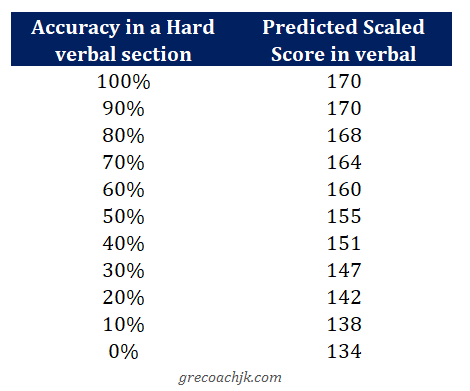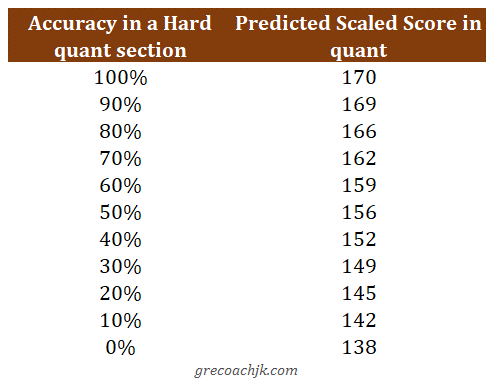During your GRE preparation, you might be curious to know how your accuracy in the practice exercises maps to scaled scores on the GRE. You may use the following tables to know this. These tables are based on the scoring formulae for the quant and verbal sections that I have reverse-engineered from my analysis of dozens of actual GRE score reports.
A caveat: The scaled score indicated below for your accuracy in a practice exercise will be valid only if you solved that exercise in the same average time limit per question as the GRE (1.75 minutes per quant question and 1.5 minutes per verbal question). If, however, you took more time than that, then you should adjust your scaled score downwards in direct proportion to the extra time taken.
The first two tables are for verbal – the table for medium difficulty sets comes first, followed by the table for hard difficulty sets.
The last two tables are for quant – the first table is for medium difficulty sets and the second, for hard difficulty sets.




So, as an example, let’s read the tables to know for what accuracy in the GRE will you get a Q160:
A scaled score of Q160 corresponds to an accuracy of about 80% in a Medium difficulty set. So, if both your scored quant sections in the GRE are of Medium difficulty level, then, to get a Q160, you will have to get a combined raw score of 32/40 (== 80% accuracy overall).
Conversely, let’s say that your accuracy in the Medium difficulty first Quant section is 90% and in the Hard difficulty second Quant section is 70%, then, what will your scaled score be? Here is how to figure that out:
- Read the 90% value from the Medium difficulty table for Quant
- Read the 70% value from the Hard difficulty table for Quant
- Average the two scaled scores obtained.
So, in this example, your scaled quant score will be equal to Q(162+162)/2 == Q162
And in a similar manner, you can calculate your scaled score for any combination of Section 1 and section 2 accuracies.